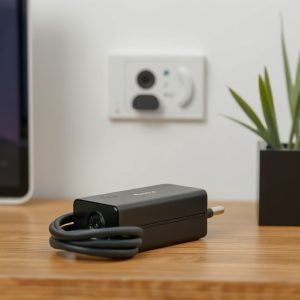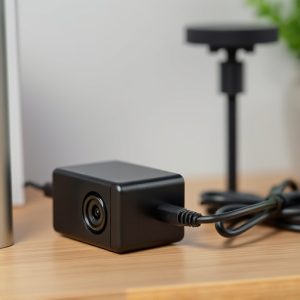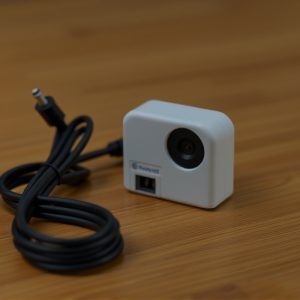Securing Your Sanctuary: Hidden Camera Strategies with AC Adapter DVR
The evolution of home security has led to the emergence of discreet yet effective solutions like th…….
The evolution of home security has led to the emergence of discreet yet effective solutions like the AC adapter hidden camera with a built-in DVR, designed to seamlessly integrate into household items, providing high-quality continuous surveillance. These cameras, which double as commonplace power adapters, offer motion detection and flexible recording modes, including scheduled and continuous, ensuring they serve as vigilant protectors of homes. They excel in various lighting conditions and support cloud storage services for remote access and real-time monitoring via smartphones or computers, offering a robust security solution that doesn't compromise on aesthetic appeal. Advanced features such as high-quality lenses, motion detection, and infrared illumination ensure round-the-clock surveillance. For homeowners, these systems represent not just a physical barrier against intruders but also a tool for evidence documentation. Additionally, the article section addresses the strategic placement of these cameras to maximize coverage without intruding on privacy, emphasizing the importance of maintaining ethical standards and legal compliance in the use of such surveillance tools. Regular system updates and maintenance are essential to ensure their effectiveness as a security measure, and open dialogue about their presence is crucial for upholding trust within the home environment.
In an era where home security transcends mere deterrence, savvy homeowners are turning to discreet, advanced solutions. This article delves into the realm of home surveillance, starting with the stealthy “Home Security Guardian”—the AC adapter hidden camera with built-in DVR. We explore its components and functionality, offering insights into a robust home surveillance system. Strategic placement tips ensure optimal coverage while maintaining privacy. Beyond the technical aspects, we navigate the complex legal landscape and ethical implications surrounding home surveillance technology. Ensuring peace of mind doesn’t come at the expense of your rights or the trust of those within your walls.
Unveiling the Stealthy Home Guardian: Ac Adapter Hidden Camera with Built-In DVR
In the realm of home security, discerning homeowners are increasingly turning to unobtrusive solutions that offer both safety and aesthetic harmony. One such innovation is the AC adapter hidden camera with built-in DVR, a device that masterfully blends into everyday household items, such as a charger or power supply. This camera’s design ensures it remains inconspicuous while capturing high-quality footage around the clock. The integration of a DVR within the same unit eliminates the need for additional recording equipment, streamlining your security setup and providing a centralized repository of video evidence in case of an incident. With motion detection capabilities and the ability to record continuously or on a scheduled basis, this device stands as a vigilant sentinel, safeguarding your home with minimal visibility yet maximum efficiency.
When it comes to monitoring your home, the AC adapter hidden camera with built-in DVR offers unparalleled peace of mind. It records in real-time, allowing you to review footage at any point. The high-resolution video ensures that even in low light conditions, images are clear and identifiable, a critical feature for capturing crucial details. Additionally, this camera supports remote access through cloud storage services, enabling you to view live feeds or download videos from your smartphone or computer. This level of surveillance technology is not just about deterrence; it’s about having eyes on your home at all times, ready to capture important moments and provide invaluable evidence should the need arise.
The Anatomy of a Hidden Camera System: Components and Functionality
A comprehensive home security setup often includes discreet surveillance components, such as an ac adapter hidden camera with a built-in DVR, which play a pivotal role in safeguarding one’s property. These cameras are designed to blend seamlessly into the environment, capturing high-resolution footage around the clock without drawing attention. The core components of this system typically consist of the camera units themselves, each equipped with a high-quality lens for clear visuals and an ac adapter to ensure consistent power supply. The cameras are connected to a DVR or digital video recorder, which stores, processes, and archives the footage they collect. The DVR is the central nervous system of the surveillance setup, enabling users to review, analyze, and manage recorded data either on-site or remotely through integrated software applications. It often includes features such as motion detection, which triggers recording upon movement within the camera’s field of view, thereby optimizing storage space and focusing on capturing significant events. Additionally, these systems may incorporate infrared illumination for nighttime surveillance, ensuring that the cameras can monitor areas even under low-light or complete darkness conditions. This level of functionality makes the ac adapter hidden camera with a built-in DVR an indispensable tool for homeowners seeking to enhance their security measures.
Maximizing Safety and Privacy: Strategic Placement Tips for Hidden Cameras
Enhancing home security involves more than just installing cameras; it’s about maximizing safety and privacy while ensuring that your surveillance system remains discreet. When considering an ac adapter hidden camera with a built-in DVR, strategic placement is key to capturing clear footage without drawing attention. These devices are compact and designed to blend into various environments, offering a covert eye for your property. Optimal positions for such cameras include high-traffic areas like entrances and hallways, as well as valuables like safes or home offices. Positioning them at heights that overlook access points, like doors and windows, can provide a comprehensive view of any activity. Additionally, ensure they are angled to avoid capturing sensitive personal spaces while still providing a wide field of view for monitoring. The built-in DVR functionality allows for ample storage of footage, which can be invaluable for reviewing any suspicious activities after the fact. It’s important to regularly check and maintain these systems, updating their firmware and ensuring they are functioning correctly to maintain their effectiveness as a deterrent against intruders or theft.
Legal Considerations and Ethical Implications of Home Surveillance Technology
The deployment of home surveillance technology, including devices equipped with an AC adapter hidden camera with a built-in DVR, raises several legal considerations and ethical implications that are pivotal for consumers to understand. From a legal standpoint, it is imperative to be aware of state and federal laws regarding privacy and surveillance. Each jurisdiction may have specific regulations concerning the placement and operation of cameras within one’s own residence as well as those monitoring public or neighboring property. Homeowners must ensure that their use of such technology does not infringe upon others’ privacy rights, which could lead to legal challenges or sanctions.
Moreover, ethical considerations extend beyond mere compliance with the law. The use of surveillance devices raises questions about the right to privacy for all individuals involved, including household members and visitors. It is essential to consider the implications of recording conversations and activities within a home setting. Trust and consent are foundational elements in relationships between family members, guests, and service providers; surveillance technology could potentially undermine these relationships if not used responsibly. Homeowners should carefully weigh the benefits of enhanced security against the potential erosion of trust that may result from the knowledge they are being recorded. Transparent communication about the presence and purpose of hidden cameras can help maintain trust and ensure that the use of such technology aligns with ethical standards.


